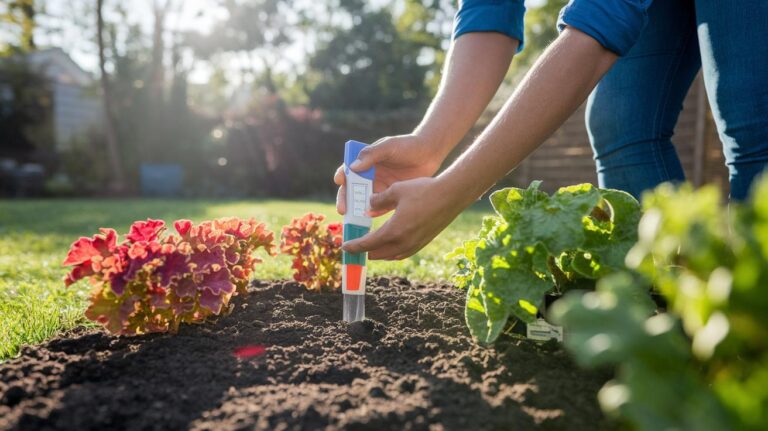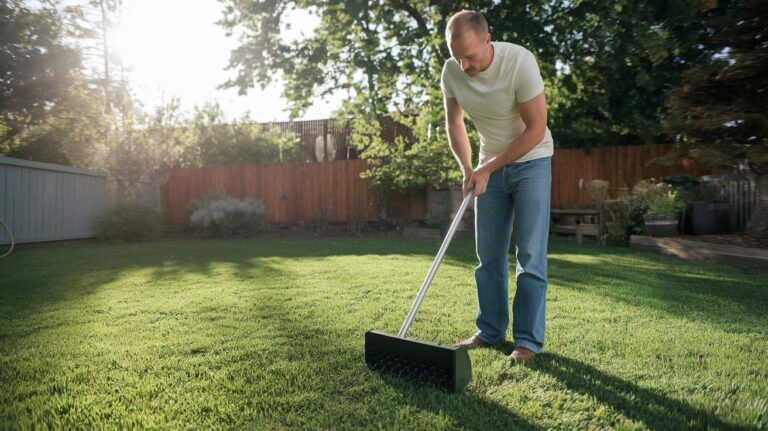How To Do Lawn Aeration For Lush Growth
Have you ever walked across your lawn and felt like you were sliding down a bowling alley instead of sinking into a soft carpet? Your grass might be gasping for air (oxygen that feeds roots).
When soil is compacted (pressed tightly), roots can’t stretch out, gulp up water, or grab nutrients. I once tried pulling a stubborn dandelion, my fork barely pierced the hard dirt. Oops, spilled a scoop of soil there.
But the trick is simple: aeration (making tiny holes). It’s like letting your grass take a deep, refreshing breath.
In the steps ahead, I’ll show you how to DIY aerate your lawn. No fancy tools needed. You’ll kneel in the cool morning earth, feeling warm soil crumble between your fingers. Then sit back and watch thicker, lush blades pop up without breaking a sweat.
Lawn Aeration Roadmap: A Quick Overview
Aeration means poking little holes in your soil. It helps air, water and nutrients seep down to thirsty roots. Your grass will perk up with a fuller, healthier look.
For cool-season grasses (like fescue and bluegrass), early fall is prime time. Warm-season lawns such as bermudagrass, zoysia or St. Augustine thrive after a late spring aeration.
You want soil that’s just damp, like a wrung-out sponge, never soggy or dry as a bone. This simple fix breaks up hard-packed dirt and gives your turf better drainage and resilience.
Ready to get started on your DIY lawn aeration plan? Just follow these steps:
- Choose timing – see [Timing Your Lawn Aeration: Season and Frequency]
- Gather tools – see [Lawn Aeration Methods and Equipment Selection]
- Prepare lawn – see [Preparing Your Lawn for Aeration]
- Aerate – see [Lawn Aeration Best Practices: Hole Depth, Spacing, and Pattern]
- Post-care – see [Post-Aeration Lawn Care: Overseeding, Topdressing, Watering]
Lawn Aeration Benefits and Soil Compaction Relief
Have you ever tried sticking your spade into soft, damp earth? That’s the feeling you get when you break up hard soil. When soil compacts, tiny air pockets get squashed tight. Roots can’t breathe, drink, or stretch out.
Aeration pokes holes in your lawn so air, water, and nutrients can slip down to thirsty roots. Before you know it, your grass weaves a strong root network and sends up thicker blades. Picture stepping on a fresh blade of grass and hearing that crisp snap, denser growth means a perkier yard.
Core aeration takes it further by pulling out little plugs of soil and thatch (the layer of dead grass bits on top). Earthworms love these holes. They wriggle in, mix their castings into your soil, and make it soft and fluffy, kind of like kneading bread dough.
When rain comes, you’ll see fewer puddles. Water flows right into the holes instead of sitting on the surface. That means less mud, fewer bare spots, and a lawn that soaks up every drop.
Watch for these compaction clues:
- A screwdriver that just won’t slide in
- Grass looking thin, yellow, or stressed
- Puddles or soggy patches after a storm
- Bare spots where nothing seems to grow
Aeration’s real gift is a lawn that drinks up rain, weathers heat, and stays lush longer.
Timing Your Lawn Aeration: Season and Frequency

When your warm-season grass like Bermudagrass, Zoysia, or St. Augustine gets cozy in the warming earth of late spring into early summer, that’s prime time for aeration (making tiny holes so air, water, and nutrients can slip down to the roots). You’ll spot roots diving into those fresh holes and growing strong. By the way, if you want to nail the perfect window, check out best time for lawn aeration.
Cool-season lawns such as Kentucky bluegrass, perennial ryegrass, or tall fescue bounce back best with an early fall aeration. In milder spots you can even slip in a session as soon as February or March, right before the grass shakes off its winter nap.
Your soil type also tells you how often to aerate. Clay soil (that thick, sticky dirt) can firm up like a brick after rain. I usually give it a yearly poke. Sandy or loamy soil (a nice, crumbly mix) stays loose for much longer so aerating every two to three years is often enough.
Have you noticed how kids and pets trampling paths turn bare spots into mud? High traffic zones pack down faster so they need more love. I aerate those areas every season, that way the grass keeps sipping up water and nutrients instead of thinning out or pooling into puddles.
Lawn Aeration Methods and Equipment Selection
Manual vs. Mechanical Aerators
Okay, manual tools ask you to dig in by hand. A core aerator (tool with hollow tubes that pull out 2- to 3-inch soil plugs) leaves tiny earth cylinders on your grass. It’s perfect for small yards or tight corners. Your arms will feel it, so plan for a few breaks.
Spike aerators (think aerator shoes or a sturdy pitchfork) push solid spikes into the soil instead of yanking anything out. They’re easier on your muscles but only poke holes.
But if your lawn runs past the driveway, mechanical aerators are your new best friend. These push-behind or tow-behind machines hook to a mower or small tractor and roll right over the turf (grass surface). Their hollow tines, about ¾ inches wide, drill down 2 to 3 inches and ease soil compaction (when dirt gets pressed tight). Most home improvement stores rent them by the day. You’ll cover more ground fast and skip the sore-shoulder stage.
So think about yard size and how much sweat you want to spend. Small patch? Manual tools save cash. Big spread? Rent a powered core aerator and finish in a flash.
Core vs. Spike Aerators
Core aerators yank out plugs, letting air, water, and nutrients slip into each hole. Those little soil cylinders break down in a week or two, feeding your grass with organic matter. You’ll notice fewer muddy patches after rain and stronger roots over time.
Spike aerators leave the soil in place, pushing dirt aside without removing it. They work great on sandy or loamy soils (loose, crumbly soils) that won’t cake back in. But clay-heavy dirt or high-traffic zones can get tighter around each hole with spikes.
If your soil is thick or deeply compacted, core aeration is the way to go. For lighter soils or a quick once-over, spike tools get the job started with less fuss.
Preparing Your Lawn for Aeration
Before you drive the aerator’s tines (the metal spikes) into your yard, check the soil moisture. It should feel like a damp sponge, soft when you squeeze it and not turning into mud or cracking like dry clay. Push a screwdriver or your hand about six inches down. If the earth holds a loose clump, you’re good to go.
- Test soil moisture by poking with a screwdriver or grabbing a handful. You want a loose clump that barely sticks together.
- Don’t aerate during a long drought or right after a heavy rain. Wet soil turns into mud and your machine will make uneven holes.
- If the thatch (dead grass bits and roots) is thicker than ¾ inch, dethatch first or give it a quick vertical mow. That clears a path for the tines to sink deep.
- Mow two or three days before aeration. Cut no more than one-third of the blade height with a sharp mower blade for clean cuts.
- Mark sprinkler heads, buried wires, rocks, and other hidden obstacles. That way you won’t bend tines or nick irrigation lines.
By the way, I once aerated too soon and ended up with mud-caked tines – lesson learned. These prep steps might take a morning but they’ll save your shoulders from strain and keep your lawn plugs neat. Ready for the next step? Let’s punch in those air and water gateways for thirsty roots.
Lawn Aeration Best Practices: Hole Depth, Spacing, and Pattern

Ever notice soggy spots on your lawn after a big rain? Getting hole depth and spacing right is like giving your grass tiny breathing tubes. When you use your aerator (tool with hollow tines that pull out soil plugs) you’ll hear a soft pop as the soil plug releases under the sun! That pop means air, water, and nutrients can slip in straight to the roots.
Aim to poke about 2 to 3 inches into the soil (the top layer where roots live). That depth lets roots dive into soft, loose earth instead of staying flat. Space holes around 3 inches apart so each soil column can crumble and mix back in. If they sit too close the turf barely moves, and if they’re too far apart you’ll still have compaction (soil squish).
Now for the pattern. Run your aerator north to south, then turn it east to west. This criss-cross makes a grid of holes so every square inch gets relief.
Got a play area or a clay-heavy patch? Go back over those spots at a 90-degree angle for extra coverage. Spike tools might need two full passes to match a core aerator’s reach. Once you’re done, give the lawn a day or two to rest so the soil tubes can stay open.
Post-Aeration Lawn Care: Overseeding, Topdressing, Watering
So you’ve aerated your lawn (you poked small holes so air, water, and roots can breathe). Tiny soil plugs will be scattered on the grass. Leave them right where they land. In about two weeks they’ll crumble, feeding earthworms and encouraging grass roots to spread.
Next, sprinkle a thin layer of compost (decayed organic matter that enriches soil) or pre‐mixed topdressing (a sandy mix you spread on your lawn) over the holes. Think of the fine, crumbly mix filling each tunnel like a cozy blanket. Have you ever felt that soft compost slip between your fingers? It adds nutrients and keeps soil light and airy.
While the holes are still open, scatter grass seed over any thin or bare patches. Pick a seed blend that matches your existing turf for a seamless look. Lightly rake to tuck seeds into the plug holes. Then step back and watch nature work its magic.
Water gently every two to three days to keep seed zones damp but not soggy. Treat the soil like a sponge, moist enough that your finger leaves a print but not so wet it pools. Wait about ten days. When tiny green blades appear, go back to your regular watering schedule.
Hold off on mowing for two to four weeks so new shoots can strengthen. When you’re ready, set your mower height to around two to three inches. A fresh, sharp blade gives a clean cut without tugging at young grass. Your patience now means thicker turf and fewer bare spots down the road.
Common Lawn Aeration Mistakes to Avoid
Aerating your lawn (making small holes in the soil) helps grass roots sip fresh air, water and nutrients. It’s like giving your turf tiny straws on a hot day!
You’ve already seen the timing tips in our Timing Your Lawn Aeration and Preparing Your Lawn guides. But watch out for these two easy-to-miss mistakes.
| Mistake | Why to Avoid |
|---|---|
| Aerating within one year of laying sod (pre-grown grass mats) or seed | Brand-new grass roots need time to spread before you poke fresh holes |
| Using spike aerators (tools that just poke holes) on clay soil (heavy, sticky ground) | That can push soil into the holes and squash the ground even tighter (compaction) |
Lawn Aeration Costs: Rental, Purchase, and Professional Services

Renting an aerator from your local home improvement or garden center usually runs $75 to $225 per day.
A liquid aeration spray (a water-based mix that helps grass roots breathe) starts around $75.
Spike aerators (tools that poke small holes) hover near $85.
Core aerators (they pull out tiny soil plugs) cost about $200.
Some shops even let you rent by the hour if you only need a few hours of use.
Buying a manual core aerator (a long-handled tool you step on to remove plugs) is a one-time spend of about $100 to $150.
Over two seasons, that investment often pays for itself and you skip the back-and-forth of rentals.
Hiring a professional to do your lawn aeration costs between $75 and $204 per visit, with a national average of about $139.
They bring the gear, handle setup and cleanup, and leave you with tidy soil ready for seed or fertilizer.
Think about how many hours you’d spend pushing or towing equipment. Sometimes it’s worth calling in a pro to save your shoulders and ensure the job gets done right. By the way, I like to drop a handful of compost (decayed organic matter that enriches soil) into each hole for extra boost.
For more local pricing details, see lawn aeration cost.
Final Words
Right in the action: we mapped out timing, benefits, methods, prep, aeration patterns, and post-care steps. You’ve seen how to pick the right season, gather tools, set your hole depth, and give your lawn the boost it needs.
Put these simple steps into practice, and you’ll nail how to do lawn aeration with ease. Your grass will breathe easier, roots will dig in deeper, and mowing will feel like a breeze.
Enjoy that lush, green carpet you earned.







